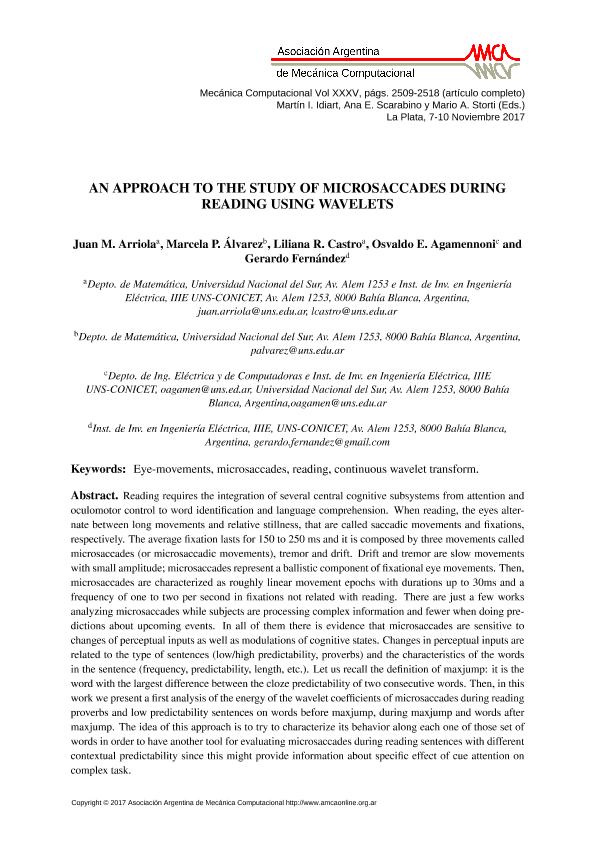Artículo
An Approach to the Study of Microsaccades during Reading Using Wavelets
Arriola, Juan Manuel ; Alvarez, Marcela Patricia; Castro, Liliana Raquel; Agamennoni, Osvaldo Enrique; Fernández, Gerardo Abel
; Alvarez, Marcela Patricia; Castro, Liliana Raquel; Agamennoni, Osvaldo Enrique; Fernández, Gerardo Abel
 ; Alvarez, Marcela Patricia; Castro, Liliana Raquel; Agamennoni, Osvaldo Enrique; Fernández, Gerardo Abel
; Alvarez, Marcela Patricia; Castro, Liliana Raquel; Agamennoni, Osvaldo Enrique; Fernández, Gerardo Abel
Fecha de publicación:
03/2018
Editorial:
Asociación Argentina de Mecánica Computacional
Revista:
Mecánica Computacional
ISSN:
2591-3522
Idioma:
Inglés
Tipo de recurso:
Artículo publicado
Clasificación temática:
Resumen
Reading requires the integration of several central cognitive subsystems from attention and oculomotor control to word identification and language comprehension. When reading, the eyes alternate between long movements and relative stillness, that are called saccadic movements and fixations, respectively. The average fixation lasts for 150 to 250 ms and it is composed by three movements called microsaccades (or microsaccadic movements), tremor and drift. Drift and tremor are slow movements with small amplitude; microsaccades represent a ballistic component of fixational eye movements. Then, microsaccades are characterized as roughly linear movement epochs with durations up to 30ms and a frequency of one to two per second in fixations not related with reading. There are just a few works analyzing microsaccades while subjects are processing complex information and fewer when doing predictions about upcoming events. In all of them there is evidence that microsaccades are sensitive to changes of perceptual inputs as well as modulations of cognitive states. Changes in perceptual inputs are related to the type of sentences (low/high predictability, proverbs) and the characteristics of the words in the sentence (frequency, predictability, length, etc.). Let us recall the definition of maxjump: it is the word with the largest difference between the cloze predictability of two consecutive words. Then, in this work we present a first analysis of the energy of the wavelet coefficients of microsaccades during reading proverbs and low predictability sentences on words before maxjump, during maxjump and words after maxjump. The idea of this approach is to try to characterize its behavior along each one of those set of words in order to have another tool for evaluating microsaccades during reading sentences with different contextual predictability since this might provide information about specific effect of cue attention on complex task.
Palabras clave:
EYE MOVEMENTS
,
MICROSACCADES
,
READING
,
WAVELET TRANSFORM
Archivos asociados
Licencia
Identificadores
Colecciones
Articulos(IIIE)
Articulos de INST.DE INVEST.EN ING.ELECTRICA "A.DESAGES"
Articulos de INST.DE INVEST.EN ING.ELECTRICA "A.DESAGES"
Citación
Arriola, Juan Manuel; Alvarez, Marcela Patricia; Castro, Liliana Raquel; Agamennoni, Osvaldo Enrique; Fernández, Gerardo Abel; An Approach to the Study of Microsaccades during Reading Using Wavelets; Asociación Argentina de Mecánica Computacional; Mecánica Computacional; XXXV; 43; 3-2018; 2509-2518
Compartir



